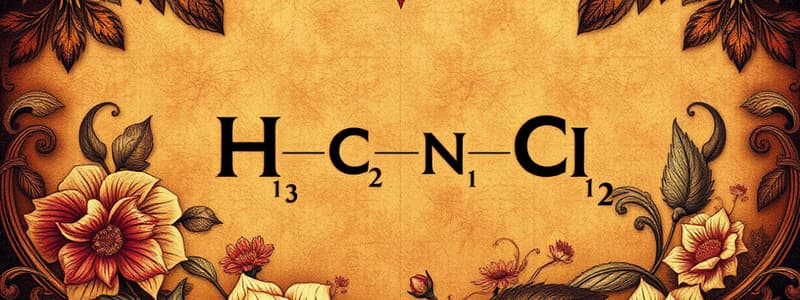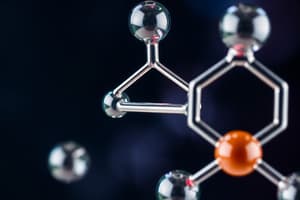Podcast
Questions and Answers
Which of the statements below concerning chemical bonds is TRUE? (Select all that apply)
Which of the statements below concerning chemical bonds is TRUE? (Select all that apply)
- All chemical bonds involve the sharing of electrons between two atoms.
- An ionic bond occurs when one or more electrons are transferred from a metal atom to a nonmetal atom. (correct)
- A covalent bond occurs when one or more electrons are transferred from a metal atom to a nonmetal atom.
- An ionic bond occurs when a metal atom and a nonmetal atom share a pair of electrons.
Which of the statements below about benzene is TRUE?
Which of the statements below about benzene is TRUE?
- The molecular formula of benzene is C12H12.
- The molecular and empirical formulas for benzene are the same.
- The empirical formula of benzene is CH. (correct)
- The molecular formula of benzene is CH.
What is the correct name for P2O5?
What is the correct name for P2O5?
- Phosphorus (V) oxide.
- Phosphorus (II) oxide.
- Phosphorus oxide.
- Diphosphorus pentoxide. (correct)
What is the formula mass of calcium nitrate, Ca(NO3)2?
What is the formula mass of calcium nitrate, Ca(NO3)2?
What is the mass percent of hydrogen in hydrogen peroxide, H2O2?
What is the mass percent of hydrogen in hydrogen peroxide, H2O2?
What is the coefficient in front of ammonia, NH3, in the balanced equation: N2 (g) + H2 (g) → NH3 (g)?
What is the coefficient in front of ammonia, NH3, in the balanced equation: N2 (g) + H2 (g) → NH3 (g)?
What is the name for the compound PCl5?
What is the name for the compound PCl5?
What is the name for the compound B2H6?
What is the name for the compound B2H6?
What is the systematic name of Mg(NO3)2?
What is the systematic name of Mg(NO3)2?
What is the systematic name of NH4ClO3?
What is the systematic name of NH4ClO3?
What is the systematic name of PbO?
What is the systematic name of PbO?
What is the empirical formula of a compound that is 62.0% C, 10.4% H, and 27.5% O by mass?
What is the empirical formula of a compound that is 62.0% C, 10.4% H, and 27.5% O by mass?
What is the formula for copper (II) sulfate pentahydrate?
What is the formula for copper (II) sulfate pentahydrate?
Give the name for H2SO4.
Give the name for H2SO4.
Determine the molecular formula of a compound that is 49.48% carbon, 5.19% hydrogen, 28.85% nitrogen, and 16.48% oxygen. The molecular weight is 194.19 g/mol.
Determine the molecular formula of a compound that is 49.48% carbon, 5.19% hydrogen, 28.85% nitrogen, and 16.48% oxygen. The molecular weight is 194.19 g/mol.
Which of the following contains BOTH ionic and covalent bonds?
Which of the following contains BOTH ionic and covalent bonds?
Which of the following would you expect to be a molecule? (Drag and drop)
Which of the following would you expect to be a molecule? (Drag and drop)
Which of the following would you expect to be part of an ionic solid? (Drag and drop)
Which of the following would you expect to be part of an ionic solid? (Drag and drop)
What is the name of the acid whose formula is HI?
What is the name of the acid whose formula is HI?
What is the formula for chlorous acid?
What is the formula for chlorous acid?
What is the name of the acid whose formula is H2CO3?
What is the name of the acid whose formula is H2CO3?
What is the formula for sulfurous acid?
What is the formula for sulfurous acid?
Classify each of the following compounds as ionic or molecular: HCN, CCl4, NI3.
Classify each of the following compounds as ionic or molecular: HCN, CCl4, NI3.
Classify each of the following compounds as ionic or molecular: PtO2, Pb(NO3)2.
Classify each of the following compounds as ionic or molecular: PtO2, Pb(NO3)2.
Name each of the following molecular compounds: PBr3, XeF8, XeF6, NO.
Name each of the following molecular compounds: PBr3, XeF8, XeF6, NO.
Write a formula for each of the following compounds: astatine monobromide, dichlorine monoxide, dinitrogen trioxide, diboron trioxide.
Write a formula for each of the following compounds: astatine monobromide, dichlorine monoxide, dinitrogen trioxide, diboron trioxide.
Use the nomenclature flow chart to name the following compound: HNO2(aq).
Use the nomenclature flow chart to name the following compound: HNO2(aq).
Use the nomenclature flow chart to name the following compound: B2Cl2.
Use the nomenclature flow chart to name the following compound: B2Cl2.
Use the nomenclature flow chart to name the following compound: BaCl2.
Use the nomenclature flow chart to name the following compound: BaCl2.
Use the nomenclature flow chart to name the following compound: CrCl3.
Use the nomenclature flow chart to name the following compound: CrCl3.
Write a ratio showing the relationship between the amounts of each element for the following: Part A (a), O:C.
Write a ratio showing the relationship between the amounts of each element for the following: Part A (a), O:C.
Write a ratio showing the relationship between the amounts of each element for the following: Part B (b), H:O.
Write a ratio showing the relationship between the amounts of each element for the following: Part B (b), H:O.
Write a ratio showing the relationship between the amounts of each element for the following: Part C (c), H:O.
Write a ratio showing the relationship between the amounts of each element for the following: Part C (c), H:O.
Flashcards are hidden until you start studying
Study Notes
Chemical Bonds
- Ionic bonds form when electrons transfer from a metal to a nonmetal.
- Covalent bonds involve the sharing of electron pairs between atoms.
Benzene
- Chemical formula: C6H6.
- Empirical formula: CH.
Compound Naming
- P2O5 is called diphosphorus pentoxide.
- Mg(NO3)2 is referred to as magnesium nitrate.
- B2H6 is known as diboron hexahydride.
- H2SO4 is identified as sulfuric acid.
- NH4ClO3 is named ammonium chlorate.
- PbO is lead(II) oxide.
Chemical Compositions
- Calcium nitrate (Ca(NO3)2) has a formula mass of 164 g/mol.
- Hydrogen peroxide (H2O2) has a mass percent of hydrogen equal to 5.9%.
- Empirical formula for a compound with 62.0% C, 10.4% H, and 27.5% O is C3H6O.
- The molecular formula for a compound with 49.48% carbon, 5.19% hydrogen, 28.85% nitrogen, and 16.48% oxygen is C8H10N4O2.
Balancing Chemical Equations
- In the reaction N2 + H2 → NH3, the coefficient in front of NH3 is 2.
Molecular vs Ionic Compounds
- Molecular compounds include: HCl, CO, SO, and phosphorous trichloride.
- Ionic compounds include: KCl, NaI, MgO, KF, CaS, barium chloride, potassium iodide, strontium iodide, and aluminum sulfide.
Acids and Their Formulas
- HI is known as hydroiodic acid.
- Chlorous acid has the formula HClO2.
- H2CO3 is called carbonic acid.
- Sulfurous acid is represented by H2SO3.
Classification of Compounds
- Molecular compounds: HCN, CCl4, NI3.
- Ionic compounds: PtO2, Pb(NO3)2.
Naming Molecular Compounds
- PBr3 is phosphorus tribromide.
- XeF8 is xenon octafluoride.
- XeF6 is xenon hexafluoride.
- NO is nitric oxide.
Writing Chemical Formulas
- Astatine monobromide: AtBr.
- Dichlorine monoxide: Cl2O.
- Dinitrogen trioxide: N2O3.
- Diboron trioxide: B2O3.
Naming Using Nomenclature
- HNO2 is nitrous acid.
- B2Cl2 is diboron dichloride.
- BaCl2 is barium chloride.
- CrCl3 is chromium(III) chloride.
Element Ratios
- For the given examples, the relationships are:
- Part A: 2O:C.
- Part B: 2H:2O.
- Part C: 2H:O.
Studying That Suits You
Use AI to generate personalized quizzes and flashcards to suit your learning preferences.




